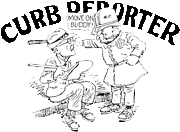The best apples
When I announced that I was going to retire, and return to my childhood hometown, people advised me that “you can’t go home again.” I responded that I knew exactly where I was going and that some things do not change: “home” is about 20 miles south of the apples and the same distance north of the peaches.
That made no sense to most of them, because they have never had these fruits right off the trees. It does matter where one obtains fresh fruits and vegetables, not to mention bread and pizza . . .
Every autumn during the 80s, Fran and I would come from Virginia to join my brother Bill and wife Mary from California to visit with Aunt Mildred on Rippy Hill. During one of our forays into the countryside we stopped at an apple orchard to get some “eating apples.” They were so good that we went back to Rome Lyda’s (a few miles east of I-26 on US 64) to get some more apples to take home with us.
Mildred Lyda met us again, polishing an apple on her skirt for each of us to munch on while we looked around. I selected a basket of Goldens, and Mrs. Lyda emptied the basket into a plastic bag in order to save the basket to use again. I assisted her in getting the bag separated in the dispenser and tried to hold it open for the transfer.
When we finally got all of the apples into the bag, she remarked as she handed it to me that she would have had it done a lot sooner if I had not been “helping!” Bill joined in the laughter, and asked if he could get his apples in a box to go on the airplane with his luggage. No problem; he wisely did not try to help.
When he pulled out a twenty to pay, Mrs. Lyda shot a look at Mary, and asked her if she knew Bill had this Big Money? As we headed for the car with our burdens, Mrs. Lyda thanked us for helping to keep the Lyda family warm in the winter.
The next year Mrs. Lyda greeted us with the free samples, and she gave me mine last: it was the smallest, most shriveled little apple I have ever seen. After good laughs all around, she then gave me the beautiful Golden Delicious she had been polishing for me.
We have bought our apples from Mildred Lyda for more than 15 years now. This year I bought a few at a more convenient location, and that was a mistake I will not make again. I made two special trips out there to get good eating apples from my favorite growers. Mildred was at a funeral the first time, but her daughter got me a bag picked for eating. This last visit was on a cold morning during the week, but Rome came out to see that I got one more bag of delicious Goldens.
Does anyone like those very red Delicious apples with the thick skins and tasteless mush inside that lie in splendor in the produce bins at the supermarkets? I just read where the growers in Washington state are changing varieties nowadays as their trees mature. They admit that they ruined a good apple by breeding to supermarket specifications and what the public supposedly wants. The Granny Smith made large inroads into the market because it is a good apple for cooking and eating.
The same goes for the tough-skinned tomatoes picked green by machines and turned red by exposure to gas in the packing line. They do not compare to a vine-ripened tomato picked at the right time and eaten the same day. We have done this to ourselves by insisting on appearance and year-round availability as primary criteria for purchase.
Does anyone want to drink apple juice from Red China instead of Hendersonville? Apples are lying on the ground under the trees because the juice market collapsed again right at harvest time. I have not forgotten the Korean War, so I do not want to buy anything that was made in Red China. Is it worth losing our Henderson County orchards to sell American soft drinks and hamburgers in Red China?



